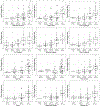Optimizing hand-function patient outcome measures for inclusion body myositis
- PMID: 32928647
- PMCID: PMC9756909
- DOI: 10.1016/j.nmd.2020.08.358
Optimizing hand-function patient outcome measures for inclusion body myositis
Abstract
Inclusion body myositis is the most commonly acquired myopathy after the age of 45. The slowly progressive and heterogeneous disorder is a challenge for measuring clinical trial efficacy. One current method for measuring progression utilizes the Inclusion Body Myositis-Functional Rating Scale. We have found that the upper extremity domain scores in the Inclusion Body Myositis-Functional Rating Scale do not consistently change until there is extreme loss of grip and finger flexor strength. Therefore, we performed a cross-sectional observational study of 83 inclusion body myositis patients and 38 controls recruited at the 2019 Annual Patient Conference of The Myositis Association. We evaluated new Inclusion Body Myositis Patient-Reported Outcome measures for upper extremity function modified from the NIH Patient-Reported Outcomes Measurement Information System as well as pinch and grip strength. We found that Patient-Reported Outcome measures hand-function have a higher correlation with pinch and grip strength than the Inclusion Body Myositis-Functional Rating Scale.
Keywords: Functional rating scale; Grip strength; Inclusion body myositis; Outcome measures; Patient reported outcome; Pinch strength.
Copyright © 2020 Elsevier B.V. All rights reserved.
Figures





References
Publication types
MeSH terms
Grants and funding
LinkOut - more resources
Full Text Sources

